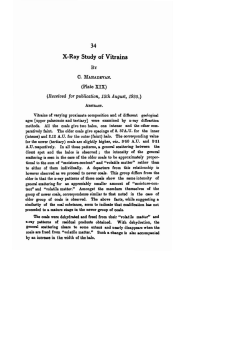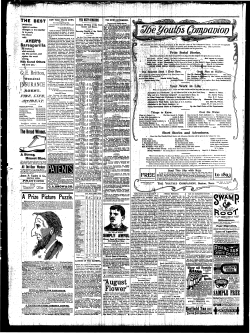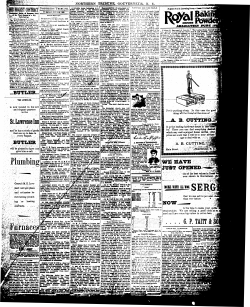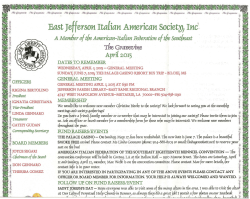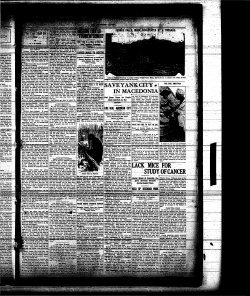
AN OPTICAL SENSOR BASED ON LAYERED FABRY
Mo/ecu/ar and Quantum Acouslics vol. 24, (2003) 125 AN OPTICAL SENSOR BASED ON LAYERED FABRY-PEROT INTERFEROMETER FOR MEASURE OF GASENOUS Hl IN VARIOUS MEDIA Erwin MACIAK' , Zbigniew OPILSKI, Mańan URBAŃCZYK Dept. ofOptoelectronies, Institute ofPhysies, Silesian University ofTechnology, 2 Krzywoustego Str., 44-100 Gliwice, POLAND *emaeiak@polsl.gliwiee.pl, tel. +48 32 2372539, fax +48 32 237 2216 The papcr prescnts a Iayered sensing structure that permits to detect and to measure the concentration oC bydrogen in a gaseous mediwn. This metal-dielcctric-metal structure is a layered Fabry-Perot interferometer. Tbe resonant cavity is made oC SiO, by sol-gel method. Tbe catalysis oC molecular hydrogen to atomie hydrogen occurs in me palladium mirrors Dr the inteńerometer. łayer, which is also one or the The measurement oC the hydrogen concentration consists in lhe scanning of the angular variation oC tbe inteńerence peak position due to the absorption oi hydrogen. Tbe change of the peaIc position results fiom the change of the optical paramet"" of the Pd laycr. KeyworrJs: Optical hydrogen sensor Jayered inteńerometer Fabry-Perot. I. INTRODUCTION In latest times more and more new industrial applications of hydrogen have beeo introdueed. Among others, it has been pl.nned to employ it as • pure energy earrier. High expeetations are connected with its .pplie.tion as a source of energy in fuel eells and also to drive motor-car engines. Moreover, due to its considerable thermaJ capacity it is used as a cooling agent, e.g. in power stations. Because jointly with oxygen at a concentration of 4% to 74% it is a highly explosive g.s, its utilisation requires special safety me.sures [1-3]. This is eonneeted with the neeessity of monitoring its emuents to prevent explosions. Henee the neeessity of monitoring its concentr.tion in an air, and also the designing of hydrogen sensors. Hydrogen sensors, now commercially av.il.ble, are not applied on a larger scale is due to their large dimensions, complicated structure, considerable costs of production and - which is most important - due to the high hazard of explosion in a medium eonstituting • mixture of hydrogen and air. Therefore, new solutions musI be looked for, whieh would w.rrant an exael, eheap and safe deteetion of hydrogen in a wider range of coneentrations. Optieal hydrogen sensors display better properties than other sensors; .mong others they are resistant to Maciak E., Gpi/ski z., Urbańczyk M. 126 electromagnetic disturbances. Thanks to their construction they warrant safety, which is of much importance in media with a high hazard of explosion. This is their integral feature. Moreover, the sensor layers of optical sensors are characterized by their long-term stability. The degradation of sensor layer structures caused by measurements is slower than in the case of electrical measurements. In the present paper the authors suggest the ides of a gasochromic hydro gen sensor based on tbe structure of a layered Fabry-Perot interferometer. Tbe resonance cavity is a layer ofSiO,. Tbe function ofthe first mirror is performed by a semi-permeable tbin Au layer. The second mirror is a thin Pd layer. The sensor part is optionally equipped with an additional Ag I.yer, 100 nm thick, with the purpose of providing a screening of the field of the electromagnetic wave outside tbe layer system. Sucb a system of layers is insensitive to variations of tbe refractive index of tbe medium above the system of layers. II is, however, sensitive to cbanges of tbe optical properties of the resonance cavity and tbe mirror made of palladium, due to tbe penetration of hydrogen through tbe system of layers. As hydrogen is an element with tbe sbortesl ion radius, this penetration is comparatively fast. Sucb a solution makes it passible to measure the concentration of solved hydrogen not only in gases but also in Iiquids. The Fabry-Perot interferometer is a kind of an optical resonator, containing two semipermeable mirrors spatially separated from eacb otber by the resonance cavity witb tbe thiclmess d and tbe refractive index n. Let's assume that botb mirrors are cbaracteńzed by tbe same coeflicient of reflection R and a loss-Iess resonance cavity. Tben tbe reflectance RFP and transmittance TFP of sucb a system looks like that: R FI' T II' =r 2R(1- COS9') = I+R' -2Rcos9' (I) (I-R)' I+R' -2Rcosą> (2) II' '" = I = wbere 9' = (4tr1J.)n d cose, is the shift of tbe pbase of a wave passing tbe cavity in both directions, J. is tbe wavelengtb and Gl is incident angle of light. From equation (I) it results tbat iftbe 9' = 0, the intensity ofthe reflected ligbt reacbes its minimum, and if 9' = 7t rod tbe reflectance of tbe structure is at its maximum. Tbe pbase may be alfected by a cbange of tbe refractive index and (ar) by cbanging the tbielmess ofthe resonanee cavity. Eq. (I) indicates also in wbieh way tbe pbase sbift alfeets the intensity of the Iigbt refleeted from tbe structure fR . The intensity oftbe ligbt f R is expressed by Airy's function : 127 Mo/ecu/ar and Quantum Acoustics vol. 24, (2003) I R = 2RI o (J - cos <p ) 1 + R' - 2R cos <p , (3) where lo is the intensity ofthe incident light the structure. Ifthe strueture is lighted with wbite light at a given angle, we can observe in the spectrum of the reflected light an interference minimum. 2. CONCEPT OF LAYERED SENSING STRUCTURE The idea of a layered sensing structure metal-dielectric-metal applied in optical sensors, as proposed by the aulhors, comprises Ihe applicalion of a calalytic Pd layer and a layer of amorphous SiO,as Ihe receptor of hydrogen (Fig. 1). In Ihe suggested strueture of the sensor the successive layers have the following funetions: a) the thin layer ofgold, 30 nm thick, funetions as the first mirror ofthe interferometer, b) the dieleetrie SiO, layer eonslitutes the resonance cavity of the interferometer and by adjusting the thielmess and alfeeting the optieal properties (refractive index) it makes it possible to tune the interferometer within a wide range, c) the palladium layer is at the same tim. a catalyst ensuring Ihe dissociation of molecular hydrogen and the second mirror ofthe interferometer wilh modulated sensor properties, d) the sitver layer with a thiclmess of 100 nm warrants the independence of the measuring system of the parameters of the medium in which measurements are taken and also separales Ihe calatytic Pd layer from the measured, Fig. l . Exposure to gas mlxture 00 nm Ag layer (Hl In SyntheUc alr) 20 nm Pd layer _-""nm 510 2 sol1łel1ayer _ _-'3'nmAu o----<:"ve,glass slide 1 mm thlck Incldenł IIghł Renected IIghł Fig. l Configwation oflayered Fabry-Perot sensing structure for hydrogen detection. Strueture shows on Fig. 1 is an extremely asymmetric Fabry-Perot interferometer, in which the second mirror has a ref1ection coefficient about 100 %. The idea or such a sensor element aimed at arresting the whole energy ofthe light wave inside the strueture, so that it would not penetrate the measured medium. Sueh a eonstruetion ensures a sbielding of the Maciak E. , Gpi/ski z., Urbańczyk M. 128 eleetromagnetic field by the Ag layer, and thus a cutting olf from the elfeets of optical variations of the parameters of the measured medium. Trus sensor is sensitive ooły to the extemal agent, i.e. the hydrogen, assuming, of course, that this agent would modify the optical parameters of the strueture, or putting it more accurately, would alfeet the resonance cavity of the etalon. 3. EXPERIMENTAL The metallic layers were produced by vacuum evaporation at 2xIO" Tr of pure Pd, Au and Ag (99.99 % A1drich) on substrates l mm thick made of cover glass si ide. The thickness . of the vacuum evaporated Pd layers was measured in situ by means of a resonance thickness meter with an accuracy of 3 %. The layer of silicon dioxide was produced by sol-gel method. Git outlet I~G;;-a:'s~l-...- - Hydrogen ,----1 server ,;!;:;;;;;;;;;;;;;;;;;;;;;;!;? Synthetfe alr Sen. Ing Itructure Invneralon aU ,---------------------------,, SF14 Prl.m CoIllmłllng Halogen optIal 1:±-T)'St1l1l : .' llumłnatof '. PoIl I Uf : 1 ______ - - - - - - - - - - - - - - - - - - - _ . ' Source modul Abeł·opSc Spectrom'WI ~------------------------_: Detection modul Fig. 2. A experimenta1 set-up for measurements oC varialions in the optical signal oC a white light with p and s polarization rcflected Crom the sensor structures. The substrates with generated sensor structur.s were coupled on immersion oil with a cylindrical prism, made of SFI4 glass (Schott). This prism ensured a mechanical stability of the optical system and warranted an adequate range of light-wave veetors. The dispersion of the refractive index of the oil was more or less the same as that of cover glass. Fig. I ilIustrates the configuration of the multi-Iayer sensing structure applied in aur investigations af interference phenamena. The measurement system employed in these investigations has been presented in Fig. 2. The idea of these measurements was to obtain ref1ection charaeteristics both as a function of the angle and the wavelength, as well as when exposed to a mixture of .ynthetic air (80 % N" 20 % 0,) and hydrogen with a varying volumetric content of hydrogen. Gases with a purity of 99.99% were mixed in a stacker provided with Bronkhorsl H-Tech mass f1ow-controllers. A gas server permitted the batching of the gas mixture with a precision exceeding 0.1 %. The Mo/ecu/ar and Quantum Acoustics vol. 24, (2003) 129 gas mixtUre passed a (teflon) measuring celi with a volume of about 0.8 cm' at a speed of 1000ml/min. The tested sensor struetures were placed on agoniometer permitting their angular seanning with an aceuraey of the angle-setting exeeeding 0.01 deg. The system also warranted an automatized determination ofthe incidenee normal ofthe optieal beam. A halogen illuminator elJlitted the incident beam of polyehromatic Iight at the strueture. By means of the fiber-optie eable it was transmitted to the goniometrie measuring system. Light passing through the optieal system (Fig. 2) was formed and polarized so that a parallei beam of wbite light with p or s polarization would ineident at the investigated strueture. The reflected light was recorded concerning the suecessive angular positions within the range of wavelengths 450 - 780 om. For deteclion a fiber-optic spectrometer produced by WOCAD with a resolution of 7 om was applied. These measurements were corried out with o tenfold average. The exposure lime was in eaeh case 1000 ms. Ali these measurements were carried out at a room temperature of23°C. b) a) Fig. 3. C31cu1ation reflectance oC sensing structure (with an Ag layer) as a function wavelength and angle oC incident light for <a) o-polarized and (b) (>-IlO1arized light. 4. RESULTS AND DISCUSSION The speetral refiectance of the investigated strueture metal-SiO,-metal as a function of the angle of incidenee on the strueture was modeled by means of software developed in the LabVlEWTM This model is based on Fresnel's theory and the matrix formalism of the propagation of eleclromagnetic waves thorough layered struetures [4]. The investigations concemed the visual range of spectra (450 om - 780 nm). The results of numerical simulation presented in Fig. 3 and concerning orthogonal polarizations illustrate excitation of interference phenomena in the strueture metal-Sio,-metal as a function ofthe wavelength and angle of incident. During the first stage of investigations a strueture with an extemal siłver layer was analyzed. The results of simulations have been Maciak E, Opi/ski z., Urbańczyk M. 130 gothered in Fig. 3. These relotions present the coeffieient ofrefleetion oflight !Tom a layered strueture with the eonfiguration shown in Fig. I, as o function of the angle of ineidence of light on the surfaee and the wavelength of the light. These results indieate how the interferenee minimum of the first order can be adjusted by changing the wavelength and the angle of ineidenee of the beam of Iight on the sensor strueture. b) a) ., ""C 0 .8 "C 0.8 .~ ~ .t; \0 - ~ 0.' o., 0.' o·, \ 1: ł § ' \ 0.6 6 \ ..0 I ..0 ~~"O~ "'", 'b '" ,&%'" ~~~ ~'% <O> ~..<:-"il -o ~'I>''' Fig. 4. Measured reflectance ot sensing structwe (with an Ag on the top) as a function wavelength and angle of incideilt light for (a) s-polariud light and (b) p-polarized Iigbt. a) b) <l!. \ Fig. 5. Reflccted light intcnsity change (in %) for !he sensing structure (with an Ag thin film on the top) as a function wavelength and angIe ot incident ligbl for (a) s-polariud Iight and (b) p-polarized lighl. Structure was exposed to gas mixture consisting 2% H:l: in synthetic air. A layered strueture with parameters as presented above has been constructed and its eoefficient of reflection was measured for both kinds of polarisation, S and p. The results of 131 Mo/ecu/ar and Quantum Acoustics vol. 24, (2003) these measurements have been gathered in Fig. 4. A comparison of experimental data with the results of modelling reveal some differenees resulting from the somewhat thieker SiO, layers than had been measured in situ. The reason is that SiO, layers obtained by sol-gel method display a porous and less p.eked .trueture. This is the main reason ofthe shift of experiment.1 peaks if compared with the model. The refr.etive indiee. of metal. eh.raeterizing the volumetric materiał were considered in the calculations, too. As the structure comprises thin metallic layers, the optie.1 eonstants of whieh .etu.lły differ from metal in its volume [5], there may oeeur some ditrerences between the eompared ehar.eteristieo. Fig. 5 presents • rel.tive eh.nge of the optie.1 sign.1 LISIS the inter.etion in the investig.ted spectr.1 and angular range due to the inter.etion of the strueture and the gas mixture eontaining 2 % hydrogen in .ynthetie air. The rel.tive ehange of the optie.1 .ign.1 h.s been determined in compli.nee with the rel.tion: !!.S (6) S The strueture was exposed to the etrect of the gas mixture for two hour.. After .bsorption of hydrogen by Pd mirror the optical .ign.1 eh.nge within the r.nge of the interferenee pe.k bec.use reflection coeIDeient this mirror has been eh.nged. 2.5 0.692 0.691 c .!! 2 Ó.69 N 1.5 l: u 0.689 ~u 15- "'#. 0.688 ~:.= ~ ~ ~ o 0.687 ~ li o: B.5 0.5 0.686 0.685 o .... 0.684 0.683 o 4000 8000 c o (.) 12000 -0.5 16000 Tlme (o) Fig. 6. Optica1 response vs. time of sensing structure (witb an Ag on the top) exposures to 2% of Hl in synthetic aU at room tcmpcrature. Experimenta1 conditions: s-polarized monochromatic ligbt )"::::550 nm, incident angle or light 8"'36 deg. The variation af the signal is af essential importance, as was to be expected, in the range af interferenee peaks. The response of the sensor strueture to 2 % hydrogen eoneentration re.ehes the level of 8 % in the ease of s-pol.rized lighl. In the ease of p pol.rization the Maciak E , Opi/ski Z, 132 Urbańczyk M. reaetion is a bit smaJler, as earlier model investigation bave proved. The cbaracteristic of the spectraJ-angular variation. of the optical signal display a considerable diversity of meanings in the case of shorter waves, as results from the low value oC signaJs refleeted in the range up to 480 nm. Hence the rather high uncertainty of measurement. in this range. Basing on investigations dealt with above we decided to carry out dynamie measurements only concerning light with a s-polarization. The structure was subjected to the elfeet of a gas mixture containing hydrogen with a cyclically cbanging concentration, amounting to O% and 2 % solved in synthetic air. Dynamie measurements wece carried out in the case of light with a wavelength of 550 nm incident the strueture at an angle of 36 deg. Fig. 6 presents the results of dynamie measurements carried out on a strueture with an e><temal siłver layer. These results prove that a sensor strueture with an e><temal metamc layer reacts with a slight delay to the elfect of hydrogen. In spite of the onty insignificant delay such a strueture regenerates, unfortunately, rather weakly. What more, the sensor is slow. Taking, however, into account the essential advantages of such a strueture, particularly its simple construetion, it might be said that it might be applied for the detection of hydrogen as a single indicator ofthe hydrogen concentration in various aggressive measured media. This sensing strueture can work without prism coupler. In this case range angle of incident light must be wider. Re,ults of mea,urements reflection coefficient for both orthogonal polarizations have been shown in Fig. 7. Fig. 7. Measured reflectance of sensing structure (without prism coupler) as a function wavelength and angle ofincident Iight for <a) '-polarized ligbt and (b) p-polarized Iigbt. 5. CONCLUSIONS A new and origin"1 idea of the authors is the specific configuration of the łayered sensing strueture, sensitive to hydrogen, which can be applied in various measured media, in gaseous as wall as in liquid ones. Mo/ecu/ar and Quantum Acoustics vol. 24, (2003) 133 Basing on preliminary investigations, the authors prediet that the struClUre metaldielectric~metal can ensure much better results of measurements of hydrogen concentrations in various media than by means of optical methods, applied so far, e.g. by reflection methods. The exeitation of these phenomena and monitoring of variations in the intensity of the interferenee lines arising due to the elfeet of hydrogen make it possible to aehieve a higher sensitivity of the structures than in the case of simple reflection sensors. In this way the sensor properties ofthe sensors become more universal. Thus, the suggested struClUre provides universal sensor properties beeause the layer constituting a metaJlic cover permits a shielding oC the electromagnetic field penetrating into the measured medium. In this way the influence of variations in this medium can be cut-oif and the ageing of the palladium layer ean be delayed. The structure displays eharaeteristie angolar fealures (minima), whieh ean be easily recorded and analysed while being exposed lo the elIeet ofhydrogen. ACKNOWLEDGMENTS The authors acknowledge Ihe Polish Stale Committee of Scienlific Researches (KBN) for financial support under the Grant 4T10C 023 24. Aulhors would like lo Ihank Dr P. Karasiński and PhD student 1. Zielonka for preparation silieon dioxide layers by sol-gel method. REFERENCES I. M. Tabib-Azar, B. Sulapun, R. Petriek, A. Kazemi, Sens. Actualors B, 56, 158-163, 1999. 2. E. Maeiak, Z. Opilski, in Proc. 9th Conferenee Oplical Fibres and their Applicalions, Krasnobród, Poland, pp. 347-359, 2003 . 3. Z. Opilski, E. Maeiak, in Proc. 9th Conference Oplical Fibres and Iheir Appliealions, Krasnobród, Poland, pp. 360-367, 2003. 4. P. Ye}l, OpticalWavesinLayeredMedia, p. 102-160, Wiley, New York, 1988. 5. MA Ordal, et al., "Oplical properties of the metaIs Al, Co, Cu, Au, Fe, Pb, Ni, Pd, Pt, Ag, Ti, and W in Ihe infrared and far infrared", Applied Oplies, 22, 1099-1120, 1983.
© Copyright 2025
